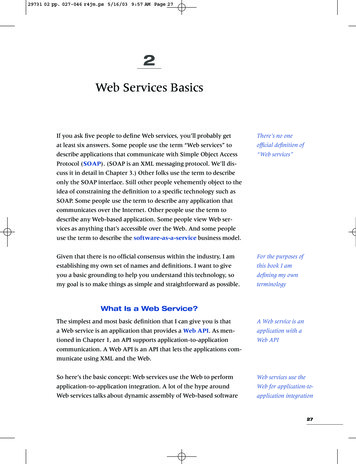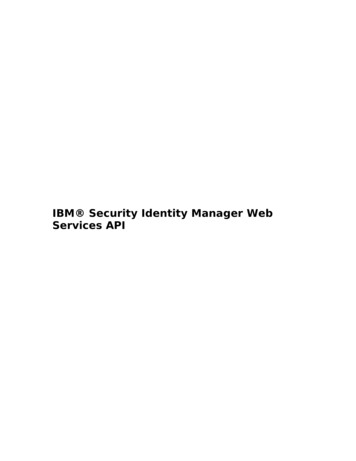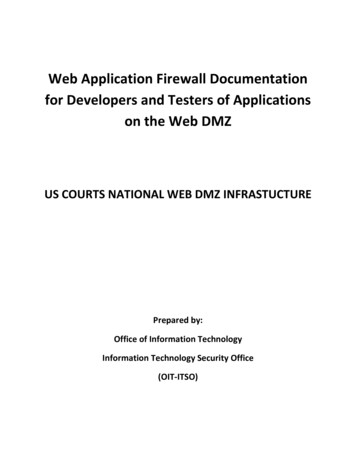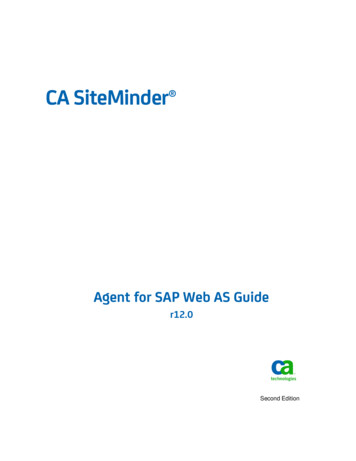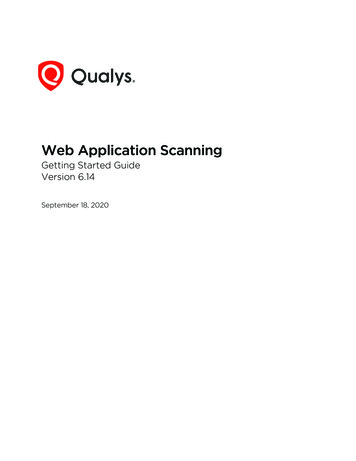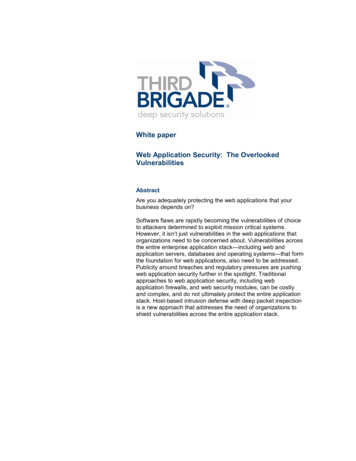
Transcription
White paperWeb Application Security: The OverlookedVulnerabilitiesAbstractAre you adequately protecting the web applications that yourbusiness depends on?Software flaws are rapidly becoming the vulnerabilities of choiceto attackers determined to exploit mission critical systems.However, it isn’t just vulnerabilities in the web applications thatorganizations need to be concerned about. Vulnerabilities acrossthe entire enterprise application stack—including web andapplication servers, databases and operating systems—that formthe foundation for web applications, also need to be addressed.Publicity around breaches and regulatory pressures are pushingweb application security further in the spotlight. Traditionalapproaches to web application security, including webapplication firewalls, and web security modules, can be costlyand complex, and do not ultimately protect the entire applicationstack. Host-based intrusion defense with deep packet inspectionis a new approach that addresses the need of organizations toshield vulnerabilities across the entire application stack.
Table of Contents1. Web Applications: An attractive target .12. Web applications are increasingly vulnerable .23. Regulations and legislation rule the new security agenda .44. Selecting a system to protect web applications.55. Your next steps.81. Web Applications: An attractive targetHow do you cost effectively defend web applications from attack? Your organization relies onmission critical business applications that contain sensitive information about customers,business processes and corporate data. Moving away from proprietary client/server applicationsto web applications gives you a simpler, cost-effective, highly extensible delivery platform. Theseapplications are more than a valuable tool to power your business operations; they are also avaluable and vulnerable target for attackers.Web applications are increasingly the preferred targets of cyber-criminals looking to profit fromidentity theft, fraud, corporate espionage, and other illegal activities. The impact of an attack canbe significant, and include costly and embarrassing service disruptions, down-time, lostproductivity, stolen data, regulatory fines, angry users and irate customers. Beyond preservingthe corporate brand, federal and state legislation and industry regulations are now requiring webapplications to be better protected.As you take action to protect web applications in a timely and effective manner, you must balancethe need for security with availability, performance and cost-effectiveness. Protecting webapplications requires both zero-day protection and rapid response with minimal impact tooperations, and must be part of a defense-in-depth plan. Look to host-based intrusion defensesystems to provide comprehensive security to proactively protect hosts, applications andsensitive data without impacting performance or changing system architectures. 2006, Third Brigade, Incwww.thirdbrigade.com,1
2. Web applications are increasingly vulnerableRapid growth leads to emerging problemsThe number of corporate web applications has grown exponentially and most organizations arecontinuing to add new applications to their operations. With this rapid growth come commonsecurity challenges driven by complexity and inconsistency. New awareness into web applicationvulnerabilities, thanks to organizations such as the Open Web Application Security Project(OWASP), has helped organizations identify application security as a priority. But according to a1June, 2006 survey , while 70 percent of software developers indicated that their employersemphasize the importance of application security, only 29 percent stated that security was alwayspart of the development process.The overlooked vulnerabilitiesUnfortunately, it is not just application flaws that are leaving systems vulnerable. In addition toapplication issues, every web application relies on a large stack of commercial and customsoftware components. The operating system, web server, database and all the other criticalcomponents of this application stack, have vulnerabilities that are regularly being discovered andcommunicated to friend and foe alike. It is these vulnerabilities that most organizations overlookwhen they’re considering web application security.The challenge this poses for IT Administrators and security professionals is that regardless of thesource of the leak, application code or underlying software, they need to their keep missioncritical applications secure.1Symantec, .jsp?prid 20060919 01 2006, Third Brigade, Incwww.thirdbrigade.com,2
Figure 1: Typical vulnerability targets in web applicationsWeb Application InfrastructureWeb ServerApp ServerDatabaseMicrosoft, Apache, Netscape BEA, IBM, Oracle, Sun Oracle, Microsoft, Sybase, IBM Un-authenticatedAuthenticatedOSOSOSWindows, Linux, SolarisWindows, Linux, SolarisWindows, Linux, SolarisFirewallApplication and OS Vulnerabilities:– Remote code execution– Cross-site scripting flaws– Command injections– Denial of Service– Improper error handlingFirewallInsiderAs noted in Figure 1, threats against applications can come from a variety of sources:-Insiders: A small number of insiders who have the greatest level of access to the overallsystem and the greatest choice of vulnerabilities that they can exploit;-Authenticated Users: A larger number of authenticated users that can breach a vulnerabilityanywhere in the application or the first tier of the system;-Unauthenticated Users: Any attacker on the internet able to exploit a flaw in the applicationauthentication mechanism or the web server.As new vulnerabilities are found, patches become a critical part of managing application security.The process of patch management is complex and difficult to do successfully. Even the mostproactive IT team must often reassign critical resources to deploy urgent patches, disruptingnormal operations. The time required to patch responsibly lengthens the window of time anattacker has to exploit a specific vulnerability. With thousands of vulnerabilities and patches beingannounced each year the problem continues to grow. Even organizations with the most efficientpatching processes in place can’t rely on this alone to protect them from attacks targeting webapplication vulnerabilities.Attackers look for the path of least resistanceToday’s sophisticated attackers target corporate data for financial and political gain. They knowthey can more easily exploit vulnerabilities in web application stacks versus trying to defeat wellbuilt network and perimeter security. With myriad numbers of vulnerabilities and many differenttechniques - including SQL Injection, Cross Site Scripting, Buffer Overflow, Denial of Service 2006, Third Brigade, Incwww.thirdbrigade.com,3
- there is no shortage of options for savvy attackers. In fact there have been over 4,000vulnerabilities identified in the first 9 months of 2006 and Web flaws made up the three mostcommon.2According to zone-h.org, 45% of attacks make use of vulnerabilities rather than configurationissues or brute force. Attackers are working hard to find and exploit new vulnerabilities in webapplications faster then they can be patched. The window of time, from when an attackeridentifies a vulnerability to when it is communicated and eventually patched, makes a defense-indepth strategy critical to prevent a potentially damaging intrusion.3. Regulations and legislation rule the new security agendaThe drive for compliance is dictating the security agenda for many organizations. As moreattackers target web applications, protecting them becomes an essential ingredient in compliancestrategies. From the PCI-DSS (Payment Card Industry Data Security Standard) to the datasecurity and breach laws found around the world in countries like Canada and Japan, theEuropean Union and over 20 U.S. states, nearly every organization is rolling out new practices toachieve regulatory compliance and web application security is a critical component of anyprogram. In fact, many regulations such as PCI-DSS are focused on protecting the critical datafound in web applications. The proliferation of breach notification legislation highlights one of theprimary motivations of attackers: identity theft.Data Security and Breach Notification LegislationFor companies that do business internationally, nationally or in multiple states, the growing list ofdata security legislation poses a significant problem. Countries and states often have distinctlydifferent measures spelled out in their data security laws. They each specify different triggers fornotifications and set varying requirements on what needs to be disclosed, to whom and when.Although it’s a good security practice, you can not rely on encryption to protect your businessfrom the potential costs associated with an intrusion. Organizations that were encrypting data tobe guaranteed a safe harbor from notifying customers after a breach, are now being faced withnew legislation that does not provide automatic “safe harbor” in states like Illinois and Indiana.The application of the various state and potential federal laws depends on the residency of theaccount holder whose data was compromised, forcing organizations to adopt a “notify all”2Mitre Corp, 09/2006 2006, Third Brigade, Incwww.thirdbrigade.com,4
approach rather than apply separate policies across different customer communities. This makespreventing the breach using host intrusion defense the best approach to compliance.Breaches are costly. Gartner estimates that organizations can expect a breach to cost them 90per user for investigation fees, communications, clean up and recovery, customer services, fines,3lawsuits and increased security audits. This figure does not account for the damage to thecorporate brand and potential market capitalization impacts. In contrast, Gartner estimates that itcosts organizations just 16 per user to use data security measures including intrusionprevention, encryption and security audits to prevent a breach.4PCI-DSSThe PCI-DSS provides stringent requirements for the protection of credit card data. Credit cardcompanies collaborated to develop 12 requirements for all merchants or service providers thatstore, process, or transmit cardholder data, including:-Requirement 6 : Develop and maintain secure systems and applications-Requirement 11: Regularly test security systems and processes.Requirement 6 details the need for proactive monitoring and vulnerability testing of webapplications. Organizations can be found non-compliant if they are found to have ongoingapplication vulnerabilities. Requirement 11 specifically details the use of network intrusiondetection systems, host-based intrusion detection systems, and/or intrusion prevention systemsto monitor all network traffic and alert personnel to suspected compromises. PCI-DSS hasbecome a best practices guide for organizations outside of the credit card industry because of itsclear and specific guidance on web application security.The pressure to meet regulatory requirements is mounting as is the rate that new vulnerabilitiesare being discovered. Most regulations do not make any recommendations or prescribe aspecific vendor or solution to combat web application vulnerabilities. As organizations faceincreasing pressure to take action, careful selection of the system that will provide the bestprotection can be challenging.4. Selecting a system to protect web applicationsOnce web application vulnerabilities have been identified, the ultimate solution is to fix thevulnerabilities in the web application source code itself. However, this can put you at risk of anintrusion because application fixes can often require:3,5Gartner, “Online Fraud Solved”, Avivah Liton, June 2006 2006, Third Brigade, Incwww.thirdbrigade.com,5
-Third parties to provide fixes to those components;-Multiple software components and vendors to support the changes and new versions;-Specialized expertise to make changes in custom applications;-Proper vulnerability fixing, testing and software deployment.Defense-in-depth is a common security strategy that promotes the use of multiple protectiontechniques to mitigate the risk of one component being compromised or rendered ineffective.Although web applications rely on patch management for protection from software flaws,penetration testing and publicized breaches regularly show that these applications havevulnerabilities that can be readily exploited for extended periods of time.When vulnerabilities exist and patching is not an immediate option, there are three main types oftechnologies that can be used as compensating controls to protect web applications.Option 1: Web Application FirewallsWeb Application Firewalls are network-based devices designed to provide in-depth protection forthe web application itself. However, they do not protect against vulnerabilities in operatingsystems or enterprise software that the web applications depend on. They also present anadditional challenge for encrypted traffic as they either require the termination of SSL trafficbefore it reaches the web application, which limits its protection value within the enterprise, orthey require the export and management of all of the private decryption keys. Lastly, althoughhost CPU performance may be unaffected using a web application firewall, there is the cost andcomplexity of deploying additional hardware and its impact on existing high-availability hardwarearchitectures. This additional hardware does not improve performance or availability, and for asimilar capital expenditure both security and performance can be improved using host-basedintrusion defense.Option 2: Web Server security modules (modSecurity, UrlScan)Web server security modules such as modSecurity for Apache or UrlScan for Microsoft IIS areweb server plug-ins that can be deployed on the server itself. These approaches can be used toprotect web applications, but like web application firewalls, they do not protect vulnerabilities inoperating system or enterprise software that web applications depend on.A New Option: Host-based Intrusion Defense with Deep Packet InspectionHost-based intrusion defense systems provide both IDS and IPS capabilities, on the host. Datatraffic to and from the web applications is inspected using a high performance, deep packetinspection engine that looks at both packet and payload data for malicious code and other 2006, Third Brigade, Incwww.thirdbrigade.com,6
5anomalies. Deep packet inspection has been identified by Gartner as a transformational securitytechnology because of its ability to provide fine grained protection directly at the host where it cannot be bypassed. The host intrusion defense system then enforces the rules that have beendefined: it allows good data to pass through, while blocking data that violates any rule. A trulyeffective system can also modify the data stream to neutralize potentially malicious traffic.Host intrusion defense systems can be bi-directional. That is, in addition to inspecting inbounddata for malicious code and other anomalies, they can also inspect outbound data. This helpsensure sensitive data doesn’t get into the hands of unauthorized users, and supports regulatoryrequirements.A host intrusion defense system that uses deep packet inspection can be used to get the best ofboth worlds: a software-only solution that can protect both web application vulnerabilities, as wellas vulnerabilities in the operating system and enterprise software they depend on. With littleimpact on host performance, they do not require the purchase or deployment of additionalhardware to protect critical servers from software vulnerabilities. And by running on the host, itcan inspect encrypted traffic without compromising the security value it offers.Host-based intrusion defense with deep packet inspection gives you:-Protection, without costly and time consuming application changes-Automatic protection from new vulnerabilities, so that new patches can be tested anddeployed on a scheduled basis, rather than reactively-Rapid protection against new vulnerabilities through the seamless delivery of new filters.-Protection that is fully aware of application state, and that can stop attacks like cookietampering and session hijacking-Bi-directional protection that stops both malicious incoming attacks and prevents sensitiveinformation leakageThis comprehensive solution to web application security can also provide broad multiplatformsupport, and be easily used in complex, heterogeneous environments with nominal impacts onperformance levels.5Gartner: “Hype Cycle for Infrastructure Protection, 2006” 2006, Third Brigade, Incwww.thirdbrigade.com,7
5. Your next stepsWeb applications are increasingly vulnerable and protecting them requires a system that can bothensure compliance today and meet the evolving needs of an organization for tomorrow. To meetthe challenge, organizations should continue to be diligent by regularly performing network- andapplication-level vulnerability scanning and penetration testing. In addition, organizations shouldselect and deploy compensating controls that defend in-depth, provide rapid protection to closethe vulnerability gap, with minimal impact on operations. Host-based intrusion defense systemsincrease security and ensure compliance by stopping attacks before they impact critical webapplications, data and hosts. 2006, Third Brigade, Incwww.thirdbrigade.com,8
About Third Brigade Third Brigade specializes in providing host intrusion defense systems to government, financialservices, health care, telecommunications and other organizations that need to detect andprevent attacks that exploit vulnerabilities in commercial and custom software, including webapplications. Third Brigade Deep Security enables you to create and enforce comprehensivesecurity policies that proactively protect critical applications, sensitive data, and hosts, ensureregulatory compliance, and maximize the performance of your people, processes and hosts.Unlike others, Third Brigade software is not intrusive: it is smaller, faster and simpler. ThirdBrigade. That’s control.For more information, please visit www.thirdbrigade.com, or contact us at:Corporate Headquarters40 Hines RoadSuite 200Ottawa, Ontario, CanadaK2K 2M5Toll free: 1.866.684.7332Local: 1.613.599.4505Fax: 1.613.599.8191United States Headquarters11710 Plaza America DriveSuite 2000Reston, Virginia, USA20190Toll free: 1.866.684.7332Local: 1.703.903.4479Fax: 1.613.599.8191Author ProfileBlake Sutherland, Vice President, Product Management, Third BrigadeBlake is responsible for managing the product life-cycle of Third Brigade's advanced intrusiondefense software. He works closely with customers, prospects, partners and industry tounderstand market requirements, and incorporate them into the product. Prior to joining ThirdBrigade, Blake was at Entrust, Inc., a leading Internet security company. Blake is a ProfessionalEngineer in the Province of Ontario, as well as a Certified Information Systems SecurityProfessional (CISSP), and holds a Bachelor of Applied Science degree in Engineering Physicsfrom Queen’s University.“Third Brigade”, “Deep Security Solutions”, and the Third Brigade logo are trademarks of Third Brigade, Inc. and may be registered in certain jurisdictions. All othercompany and product names are trademarks or registered trademarks of their respective owners. 2006 Third Brigade. All rights reserved. 2006, Third Brigade, Incwww.thirdbrigade.com,9
Option 1: Web Application Firewalls Web Application Firewalls are network-based devices designed to provide in-depth protection for the web application itself. However, they do not protect against vulnerabilities in operating systems or enterprise software that the web applications depend on. They also present an



